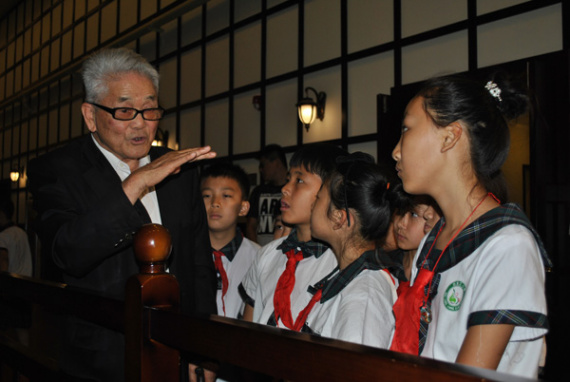
Quan Deyuan recounts bringing 36 Japanese war criminals to trial to students at the Military Tribunal Site for Japanese War Criminals in Shenyang, Liaoning province. (Photo/Chian Daily)
It is easy to find reminders of war in Shenyang, capital of Liaoning province. The Military Tribunal Site for Japanese War Criminals in the downtown area is one of them. The city was occupied by the Japanese army during World War II.
"The September 18th Incident was the beginning of the Japanese invasion of China, and the military trial in Shenyang was a part of the process of ending the aggression. The Chinese War of Resistance against Japanese Aggression (1937-45) began in Shenyang, and also ended in the city," said Wang Jianxue, chairman of the September 18th Incident Study Research Institute.
In 1956, the government set up the tribunal site to bring 36 Japanese war criminals from World War II to trial. All 36 criminals pleaded guilty, including Suzuki Keiku, lieutenant general and commander of the 117th Division of the Japanese army, and Rokusashi Takebe, chief of general affairs of "Manchukuo".
"All the criminals pleaded guilty in the face of overwhelming evidence. And they never expected that Chinese people would be able to return good for evil because none of them were sentenced to death. Some of them even knelt down in court to apologize to their Chinese victims," Quan Deyuan recalled. Now, 84, Quan was the assistant judge at the trial.
After graduation from law school at Peking University in 1954, Quan became a law teacher in Liaoning. He was selected to take court records because he was a law major and could speak Japanese.
"All the procedures of an international court were followed. According to international practice, lawyers should wear dark suits, white shirts and leather shoes. But this was in 1956, no one in China wore clothes like that, so they drew a great deal of attention when they were walking down the street."
Quan remembered clearly that on the first day of the trial on July 1, the chief judge announced to the defendants: "During the process of the trial, you can ask questions to the witnesses. You can defend yourself. Also, you have the right of a final statement."
The most unforgettable thing for Quan was the witness testimony. "A woman, whose 4-year-old daughter and mother-in-law were killed, even tried to pounce on the Japanese criminal. According to witnesses, the Japanese used numerous horrible ways to kill innocent civilians. It brought tears to my eyes in court," he said.
That's also the reason that Quan and many people couldn't understand the light sentence Japanese criminals received at that time. The war criminals were sentenced to prison terms ranging from eight to 20 years.
"However, my supervisor reminded me that these criminals used to be ordinary people. It was the Japanese government that was ultimately responsible for the war. Forgiving them was more meaningful than killing them. They could serve as envoys of friendship between the two countries in the future," Quan recalled.
"Time has proved he was right."


















































